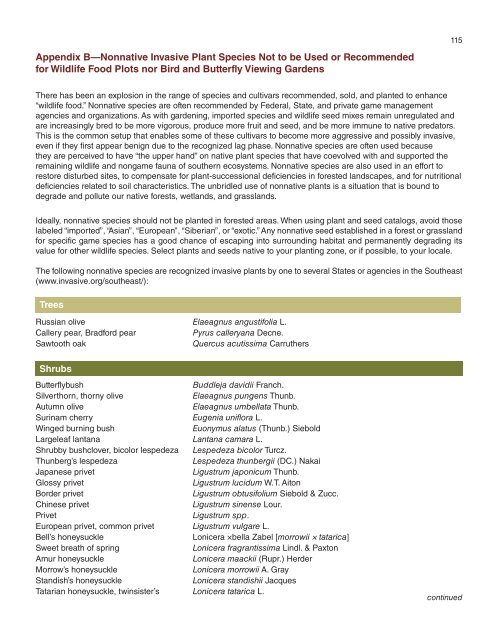A Management Guide for Invasive Plants in Southern Forests James ...
A Management Guide for Invasive Plants in Southern Forests James ...
A Management Guide for Invasive Plants in Southern Forests James ...
- No tags were found...
You also want an ePaper? Increase the reach of your titles
YUMPU automatically turns print PDFs into web optimized ePapers that Google loves.
115Appendix B —Nonnative <strong>Invasive</strong> Plant Species Not to be Used or Recommended<strong>for</strong> Wildlife Food Plots nor Bird and Butterfly View<strong>in</strong>g GardensThere has been an explosion <strong>in</strong> the range of species and cultivars recommended, sold, and planted to enhance“wildlife food.” Nonnative species are often recommended by Federal, State, and private game managementagencies and organizations. As with garden<strong>in</strong>g, imported species and wildlife seed mixes rema<strong>in</strong> unregulated andare <strong>in</strong>creas<strong>in</strong>gly bred to be more vigorous, produce more fruit and seed, and be more immune to native predators.This is the common setup that enables some of these cultivars to become more aggressive and possibly <strong>in</strong>vasive,even if they first appear benign due to the recognized lag phase. Nonnative species are often used becausethey are perceived to have “the upper hand” on native plant species that have coevolved with and supported therema<strong>in</strong><strong>in</strong>g wildlife and nongame fauna of southern ecosystems. Nonnative species are also used <strong>in</strong> an ef<strong>for</strong>t torestore disturbed sites, to compensate <strong>for</strong> plant-successional deficiencies <strong>in</strong> <strong>for</strong>ested landscapes, and <strong>for</strong> nutritionaldeficiencies related to soil characteristics. The unbridled use of nonnative plants is a situation that is bound todegrade and pollute our native <strong>for</strong>ests, wetlands, and grasslands.Ideally, nonnative species should not be planted <strong>in</strong> <strong>for</strong>ested areas. When us<strong>in</strong>g plant and seed catalogs, avoid thoselabeled “imported” , “Asian” , “European” , “Siberian” , or “exotic.” Any nonnative seed established <strong>in</strong> a <strong>for</strong>est or grassland<strong>for</strong> specific game species has a good chance of escap<strong>in</strong>g <strong>in</strong>to surround<strong>in</strong>g habitat and permanently degrad<strong>in</strong>g itsvalue <strong>for</strong> other wildlife species. Select plants and seeds native to your plant<strong>in</strong>g zone, or if possible, to your locale.The follow<strong>in</strong>g nonnative species are recognized <strong>in</strong>vasive plants by one to several States or agencies <strong>in</strong> the Southeast(www.<strong>in</strong>vasive.org/southeast/):TreesRussian olive Elaeagnus angustifolia L.Callery pear, Brad<strong>for</strong>d pearPyrus calleryana Decne.Sawtooth oakQuercus acutissima CarruthersShrubsButterflybushBuddleja davidii Franch.Silverthorn, thorny oliveElaeagnus pungens Thunb.Autumn oliveElaeagnus umbellata Thunb.Sur<strong>in</strong>am cherry Eugenia uniflora L.W<strong>in</strong>ged burn<strong>in</strong>g bushEuonymus alatus (Thunb.) SieboldLargeleaf lantana Lantana camara L.Shrubby bushclover, bicolor lespedeza Lespedeza bicolor Turcz.Thunberg’s lespedezaLespedeza thunbergii (DC.) NakaiJapanese privetLigustrum japonicum Thunb.Glossy privetLigustrum lucidum W.T. AitonBorder privetLigustrum obtusifolium Siebold & Zucc.Ch<strong>in</strong>ese privetLigustrum s<strong>in</strong>ense Lour.PrivetLigustrum spp.European privet, common privet Ligustrum vulgare L.Bell’s honeysuckleLonicera ×bella Zabel [morrowii × tatarica]Sweet breath of spr<strong>in</strong>gLonicera fragrantissima L<strong>in</strong>dl. & PaxtonAmur honeysuckleLonicera maackii (Rupr.) HerderMorrow’s honeysuckleLonicera morrowii A. GrayStandish’s honeysuckleLonicera standishii JacquesTatarian honeysuckle, tw<strong>in</strong>sister’s Lonicera tatarica L.cont<strong>in</strong>ued
















